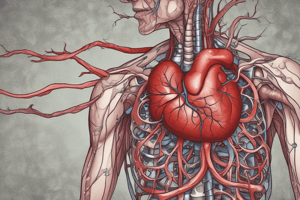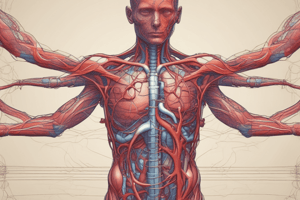Podcast
Questions and Answers
Which blood vessels drain from capillaries?
Which blood vessels drain from capillaries?
- Capillaries
- Arterioles
- Veins (correct)
- Arteries
Which class of blood vessels return blood to the heart?
Which class of blood vessels return blood to the heart?
- Arteries
- Veins (correct)
- Capillaries
- Vasculature
The walls of arteries and veins have three layers called __________.
The walls of arteries and veins have three layers called __________.
Tunics
The innermost layer of a blood vessel wall is the tunica _________.
The innermost layer of a blood vessel wall is the tunica _________.
What layer of the blood vessel wall is composed of endothelium and a subendothelial layer of areolar connective tissue?
What layer of the blood vessel wall is composed of endothelium and a subendothelial layer of areolar connective tissue?
Arteries, veins, and ________ make up the three classes of blood vessels.
Arteries, veins, and ________ make up the three classes of blood vessels.
What layer of the blood vessel wall is composed of circularly arranged layers of smooth muscle cells?
What layer of the blood vessel wall is composed of circularly arranged layers of smooth muscle cells?
Which class of blood vessels carries blood away from the heart to the body?
Which class of blood vessels carries blood away from the heart to the body?
The widening of the blood vessel lumen resulting from the relaxation of the smooth muscle of tunica media is known as ________.
The widening of the blood vessel lumen resulting from the relaxation of the smooth muscle of tunica media is known as ________.
The space within a vessel through which blood flows is the ______.
The space within a vessel through which blood flows is the ______.
The outermost layer of a blood vessel is known as the _______.
The outermost layer of a blood vessel is known as the _______.
Which is the innermost layer of a blood vessel wall?
Which is the innermost layer of a blood vessel wall?
The network of small arteries extending through the tunica externa of very large blood vessels is known as the _______ _______.
The network of small arteries extending through the tunica externa of very large blood vessels is known as the _______ _______.
The middle layer of the blood vessel wall is the ________.
The middle layer of the blood vessel wall is the ________.
Which characteristics describe the general structure of an artery?
Which characteristics describe the general structure of an artery?
The narrowing of the blood vessel lumen resulting from contraction of the smooth muscle of tunica media is known as ________.
The narrowing of the blood vessel lumen resulting from contraction of the smooth muscle of tunica media is known as ________.
Arteries branch into _______ vessels as they extend from the heart to the capillaries.
Arteries branch into _______ vessels as they extend from the heart to the capillaries.
What layer of the blood vessel wall is composed of areolar connective tissue containing elastic and collagen fibers?
What layer of the blood vessel wall is composed of areolar connective tissue containing elastic and collagen fibers?
Which type of artery has the largest lumen diameter?
Which type of artery has the largest lumen diameter?
The three layers of the walls of arteries and veins are the _______.
The three layers of the walls of arteries and veins are the _______.
Which arteries are also known as distributing arteries because they distribute blood to the body organs and tissues?
Which arteries are also known as distributing arteries because they distribute blood to the body organs and tissues?
The vasa vasorum of very large blood vessels extend through the _______.
The vasa vasorum of very large blood vessels extend through the _______.
Arteriole vasodilation ________ blood flow into an area.
Arteriole vasodilation ________ blood flow into an area.
Which characteristics describe the general structure of a vein?
Which characteristics describe the general structure of a vein?
The smallest type of arteries are the _______.
The smallest type of arteries are the _______.
Which blood vessels become progressively smaller and branch as they extend away from the heart?
Which blood vessels become progressively smaller and branch as they extend away from the heart?
Smooth muscle in the arterioles usually is at least slightly constricted. This slightly constricted state is called _________ tone.
Smooth muscle in the arterioles usually is at least slightly constricted. This slightly constricted state is called _________ tone.
Which arteries are called conducting arteries because they conduct blood away from the heart to the smaller muscular arteries?
Which arteries are called conducting arteries because they conduct blood away from the heart to the smaller muscular arteries?
The walls of capillaries contain only the _______ intima allowing for rapid gas and nutrient exchange between the blood and tissues.
The walls of capillaries contain only the _______ intima allowing for rapid gas and nutrient exchange between the blood and tissues.
The medium-sized ________ arteries are also called distributing arteries because they distribute blood to body organs and tissues.
The medium-sized ________ arteries are also called distributing arteries because they distribute blood to body organs and tissues.
Blood vessels called ________ connect arterioles to venules.
Blood vessels called ________ connect arterioles to venules.
Arteriole vasoconstriction ________ blood flow into an area.
Arteriole vasoconstriction ________ blood flow into an area.
Arterioles are _______.
Arterioles are _______.
Which are types of capillaries?
Which are types of capillaries?
Arterioles have a significant role in regulating systemic blood pressure.
Arterioles have a significant role in regulating systemic blood pressure.
Flashcards are hidden until you start studying
Study Notes
Blood Vessels Overview
- Veins drain blood from capillaries and return it to the heart.
- Arteries carry blood away from the heart to various body parts.
Structure of Blood Vessels
- All blood vessels have three layers known as tunics:
- Tunica Intima: Innermost layer made of endothelium and a subendothelial layer of areolar connective tissue.
- Tunica Media: Middle layer composed of circularly arranged smooth muscle cells; regulates blood vessel diameter.
- Tunica Externa: Outermost layer containing areolar connective tissue with elastic and collagen fibers.
Types and Functions of Blood Vessels
- Arteries: Thicker tunica media, remain open when drained (patent), and have narrower lumen compared to veins.
- Veins: Wider lumen, collapse when drained, and have a thicker tunica externa.
- Capillaries: Smallest blood vessels, facilitate rapid gas and nutrient exchange via tunica intima only.
Blood Vessel Dynamics
- Vasodilation: Widening of the blood vessel lumen due to relaxation of smooth muscle in the tunica media, increasing blood flow.
- Vasoconstriction: Narrowing of the blood vessel lumen due to contraction of smooth muscle, decreasing blood flow.
- Arterioles: Smaller arteries branching from larger arteries, involved in regulating blood flow and pressure.
Types of Arteries
- Elastic Arteries: Largest lumen diameter, conduct blood away from the heart.
- Muscular Arteries: Also called distributing arteries due to their role in distributing blood to organs and tissues.
Specialized Structures
- Vasa Vasorum: Small arteries that extend through the tunica externa of large blood vessels, supplying them with blood.
- Types of Capillaries: Include fenestrated, continuous, and sinusoids, each with specific permeability characteristics.
Regulation of Blood Flow
- Arterioles maintain a state of slight contraction known as vasomotor tone, impacting blood pressure regulation.
- Blood vessels such as capillaries connect arterioles to venules, facilitating blood flow from the arterial to the venous system.
Studying That Suits You
Use AI to generate personalized quizzes and flashcards to suit your learning preferences.




